
Bangalore International Arts Festival 2016
Photos courtesy: BIAF
October 26, 2016
Bengaluru’s acclaimed international arts festival BIAF 2016 opened its
9th edition with a gala inauguration on September 9, 2016 to an
over-packed house at Dr. Ambedkar Institute of Technology auditorium.
The evening began with a youth program involving college students
presenting their talent, which proved that today’s youth have evolved
into multi-talented vivacious young graduates.
AIM under the leadership of Dr. Suma Sudhindra and Dr. Veena Murthy
Vijay envisaged a 9 days and 7 venue festival with participation from
various states and countries. There were vibrant folk dance groups from
Bangladesh, Sri Lanka, Telangana and other states. The audience cheered
the dancers and created a joyful atmosphere making the opening a
thumping success in spite of the bandh and the delayed start due to it.
The spirit of unity, the spirit of oneness was the highlight of the folk
festival that continued at Freedom Park for the 2nd day. Folk troupes
who travelled the long distances from across the globe showed their
prowess by showcasing their land’s culture in their lively well
coordinated performances and well designed colourful costumes. Some of
the dances were traditional like Pooja Dance from Srilanka, the Flag
Dance from Bangladesh, Mathuri from Andhra, Oggu Melam from Telangana
and Shanka Naad Nruthya from Orissa. The acrobatic formations with leaps
and jumps brought a sense of eager anticipation in the audience. The
weather supported the festival, waiting until the end of the programs
before pouring with rain. Suma Sudhindra, Veena Murthy Vijay and the
team of AIM were in blue symbolising sustainable harmony. The leaders of
the team, Tilak Fernando from Sri Lanka, Vishwakarma from Telangana,
Ravi from Andhra, Nittorang from Bangladesh were honored.
The festival continued on the 3rd day at Freedom Park. Being a Sunday,
the crowd started filling the open air theatre at 5pm. The dancers from
Sudan, Rwanda and other countries enthralled the audience. Manganiyar
magic led by Bungur Khan and team was a melodious fare mixed with rustic
folk beats. Kalbelia, the Rajasthani dance with graceful serpent like
movements and acrobatic stances was an added attraction. The second half
featured music band Sushryavya performing popular Kannada film numbers
and Bhavageethe in unplugged style. The band was led by Prof. Suchethan
Rangaswamy, popular singer and TV actor, along with Supreeth Phalguna
and Aishwarya Rangarajan as co-singers, Pranav Dutt on drums,
Sharan Rao on keyboards and Sudatta LS Prasad on tabla. The large crowd
enjoyed until the end, a testimony to BIAF which is reaching out to new
audiences.
Slide show

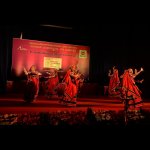
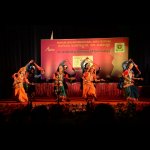

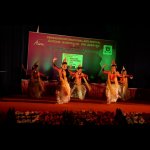
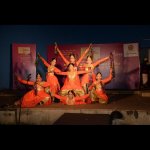
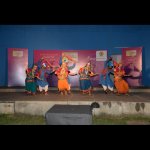
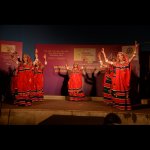
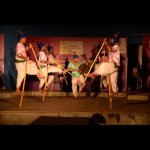
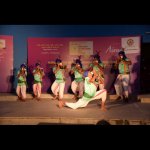
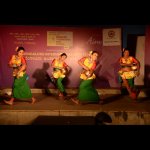
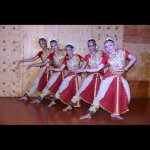
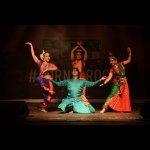
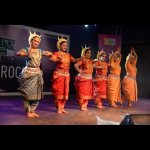
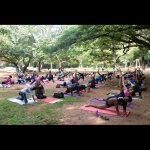
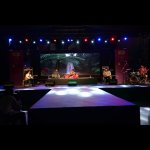
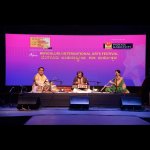
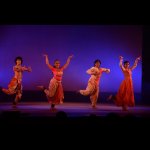
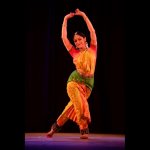
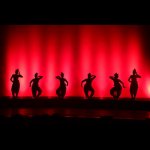
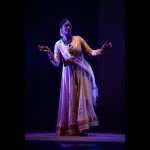
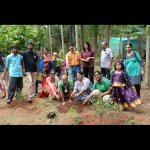

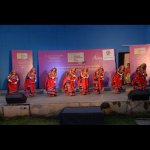
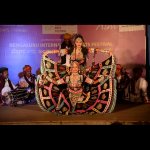
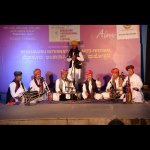
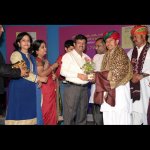
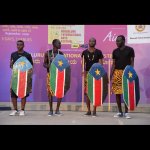
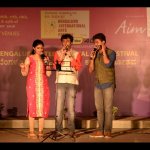
On 16th September, the program took place at Green Path Organic State.
Shraddha Dance Centre presented well coordinated and neat Bharatanatyam
performance. Shama Krishna presented specially choreographed dance
sequences by her students. The group performed Arishadvarga, depicting
the 6 weaknesses of man by narrating interesting episodes from
mythology. Another interesting number was DV Gundappa’s Antahpurageethe
describing the magic of stone sculptures of Belur and Halebid. The
sculpturesque poses based on the karanas of Natya Shastra were the
highlight of this dance presentation. The program concluded with a
thillana.
The weekend crowd at Phoenix Market City Mall, one of the 7 venues of
BIAF, was treated to unique dance performances by two groups on 17th
September. Mahari dance from Orissa was led by Sharath Chandra Das.
Staged at the Phoenix amphitheatre, the rich and unique costumes and
head gear added to the graceful dance presented by 8 dancers. The
rituals which are performed before Lord Jagannath in the temples of
Orissa and the floral tributes offered to the gods were depicted. The
second part of the evening comprised of a thematic dance production by
young dancers of different styles - Divya Ravi (Bharatanatyam),
Prateeksha Kashi (Kuchipudi), Amith Kinchi from Delhi (Kathak) and
Vandana Supriya (Odissi). The theme sketched the characteristics of the 5
elements - air, water, space, fire and earth. Amith Kinchi’s swift
swirling chakkars and fast footwork were impressive. Divya Ravi’s
powerful rendition with involved abhinaya added to the overall flow of
the theme. Kuchipudi by Prateeksha and Odissi by Vandana were presented
with lilting grace and contrasts of these forms were neatly presented
with harmony. The evening ended with all four dancers coming together in
a finale presentation showcasing their mastery in their respective
styles.
Bengaluru is known for its cosmopolitan culture, welcoming every culture
and genre of arts with an open mind to enjoy the diversities of varied
arts .This part of city has been a home to all travelling, visiting and
migrating techies and corporate business elite. The audience comprised
of new Bengaluru’s dwellers enjoying what the city has to offer amidst
its super fast growth beyond its capacity. On 18th at Phoenix Market
City Mall,
the audience enjoyed santoor by Suddhashil Chatterjee and Mexican flute
by Natalie from Mexico. The session opened with raag Yaman and
Suddhashil’s mastery over the complex santoor instrument in the
technique of raga expansion displayed his musical prowess. Natalie’s
flute added colour and melody to the concert. Her calm rendition of the
compositions in coordination with santoor made the concert appealing
with Ravikiran Nakod accompanying on the tabla.
The second half featured a fusion band Megha featuring Dr. Suma
Sudhindra on the veena, Gerard Machado on the guitar, B.C Manjunath on
mridangam, Karthik Mani on the drums and Prakash on bass guitar. This
power packed fusion band played some vibrant and melodious
numbers to the joy of the discerning music lovers. The concert began
with Suma’s opening number in fast pace, setting an impetus to foot
tapping mood of the fully packed amphitheatre. Gerard Machado’s guitar
brought in the right amount of fusion ingredient complimenting the
traditional raga rendition of the veena. Suma presented the popular
composition in Kadana Kuthuhala ragam that bore the rich stamp of
classicism. Her rendering of the fast paced phrases both in the lower
and middle octaves with care and ease was enjoyable. ‘Touch another
life’ was a fusion composition in which the energetic beats of the
mridangam and drums played in a kind of combined exchange with
complicated rhythmic combinations took the concert to new high.
Manjunath and Karthik Mani enthralled the audience with their lively
support.
The final weekend of BIAF 2016 was a success with full attendance at
Chowdiah Memorial Hall by Bengaluru’s art loving crowd on September 23.
The young and energetic group Abhjatha presented ‘Hari Hara,’ a
jugalbandi of Kathak and Bharatanatyam. The four dancers Aswin Prabhath,
Rohini, Neha Seshadrinath and Naveen Hegde, disciples of Nirupama and
Rajendra, presented stories from mythology by depicting comparative
notes on Shiva and Vishnu, Lakshmi and Parvathi. The audience watched in
eager anticipation of two of the main Hindu gods being depicted with
their unique characteristics. The finale brought all dancers concluding
in high energy synthesis of both gods’ attributes.
The second half of the evening was Bharatanatyam by Rama Vaidyanathan.
The performance highlighted the beauty of Marga in the diverse and
layered perspectives as it is evolving today since its original Sadir
form from 18th century. Rama began her recital with a powerful
composition praising Goddess Durga. Rama then moved on to 'Navarasa
Mohana' based on Bhagavat Gita verses, describing episodes in the life
of lord Krishna and the reactive mood it created in the hearts of the
people of Mathura, like sringara in the hearts of the Gopis, hasya among
his cowherd friends. The Kamsa vadha and Govardanagiri episodes were
dramatically woven into her intense and almost meditative bodily control
and concentration creating the required bhava. Through her flawless
abhinaya, she portrayed varied expressions including aggression, peace,
prayer, love and killing with remarkable finesse. The last piece was
about Radha writing a letter to Krishna of her most cherished wants,
desires and dreams. Through the writing, she gradually realises the
philosophical being within her, she finds herself as Krishna. Not
knowing this new found identity she becomes restless and starts to read
her own letters and feels that they were written to herself. This
self realization brings about total surrender to that infinite being
becoming one with it sometimes and belonging to it as a part of it other
times. Her expressions of moving emotions like the anger, pain,
pleasure, happiness, sorrow, love and lust were portrayed with masterly
grace taking the audience into the journey from the tangible subjective
to the intangible objective. Her musicians K.Venkateswaran (vocal),
Sumod Sreedharan (mridangam), Dr. S. Vasudevan (nattuvangam) and Viju S
Anand on violin complemented her with some soulful music.
In her interaction with the audience she exhorted the youth to explore
new possibilities in creativity and that one gets to learn how much
modernity or contemporary improvisation within the frame work of
classicism should be used, is understood by a dancer after falling
several times and several attempts and that should not stop creativity.
She insisted that conviction towards one’s idealism will surely lead to
the path of self evolvement. Rama Vaidyanathan’s recital was indeed
memorable.
The next evening at Chowdiah Memorial Hall saw Madhu Nataraj,
daughter/disciple of Guru Maya Rao present a scintillating performance
based on women empowerment titled ‘Like camphor on fire.’ The
presentation was on certain great thoughts of the female Shaivism gurus
who became cult figures. Nirvaya is inspired and informed by the
profound and abstract Kannada vachanas or poetry of mystics called
Sharanas.
Dance and text moved together, sometimes parallel, whilst translating
the profound concepts of women and male mystics - Lingamma, Allama
Prabhu, Molige Mahadevi and the radical poet Akka Mahadevi. Their
philosophy is Linga- advaita or monistic Shaivism, with roots in the
Vedas and Kashmiri monistic Shaivism. Madhu depicted these abstract
thoughts through motifs of Kathak swirls coupled with subtle graceful
movements bringing about the essence of Sharana salvation in ‘Nirvaya’
(becoming nothing), disappear without leaving a trace like camphor on
fire. It was a wonderful depiction of Vachanas, through visual art of
Kathak dissolving into each other in experiencing the mysticism of the
Sharana and Sharane or the larger perspective of onness of the mortal
with the immortal.
Anajasa, a colourful spectacle was staged by Apsaras Arts from
Singapore. A rare theme chosen for dance interpretation but well
executed, was conceptualised, choreographed and produced by Aravinth
Kumaraswamy, director of Apsaras Arts. Beautiful Buddhist architectural
sites of Asia were chosen to interpret the Buddhist culture through
dance. Various heritage sites like Bodh Gaya, Mahadevi temple in Nepal,
Wat Pho in Thailand and many more were chosen and projected as backdrop
from different Buddhist monumental sites across Asia. The dancers
presented certain episodes connected to the monuments with perfect
synchronization. Well coordinated dance with graceful movements conveyed
myriad emotions of the characters like the emperor Ashoka and other
kings who spread Buddhism across the world. Colourful costumes and
creative lighting made this production a visual splendour.
The 9th edition of BIAF concluded on 25th September with a saxophone
performance by Kadri Gopalnath. He was accompanied on the violin by
Vittal Ramamurthy, mridangam by Trichy B Harikumar, morsing by B.
Rajashekhar and tabla by Rajendra Nakod. He began with a composition
rendered in quick melodic notes of the raga followed by alapanas and
improvisations which displayed his musical prowess and mastery over the
instrument. The pallavi was proof of his impeccable vidwat. With “Endaro
mahanubhavulu” in ragam Sri, Kadri Gopalnath regaled the audience on
the concluding day of the festival.
|





